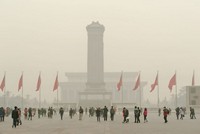Advertisement
Grab your lab coat. Let's get started
Welcome!
Welcome!
Create an account below to get 6 C&EN articles per month, receive newsletters and more - all free.
It seems this is your first time logging in online. Please enter the following information to continue.
As an ACS member you automatically get access to this site. All we need is few more details to create your reading experience.
Not you? Sign in with a different account.
Not you? Sign in with a different account.
ERROR 1
ERROR 1
ERROR 2
ERROR 2
ERROR 2
ERROR 2
ERROR 2
Password and Confirm password must match.
If you have an ACS member number, please enter it here so we can link this account to your membership. (optional)
ERROR 2
ACS values your privacy. By submitting your information, you are gaining access to C&EN and subscribing to our weekly newsletter. We use the information you provide to make your reading experience better, and we will never sell your data to third party members.
Pollution
Pollution linked to in vitro fertilization failure
Exposure to pollutants from vehicle fumes may interfere with fertility treatments
by Janet Pelley
July 22, 2019

Breathing dirty air takes a toll on heart and lung health—and, researchers are learning, its damaging effects extend to other organs as well. Over the last decade, scientists have even linked road pollution exposure to reproductive harm such as infertility and miscarriage. Now, a new study concludes that women with higher exposures to car and truck fumes are more likely to experience failure of in vitro fertilization (IVF). And those failures occur early, during the formation of embryos (Environ. Health Perspect. 2019, DOI: 10.1289/EHP4601).
Infertility afflicts over 10% of women worldwide. This dispiriting reproductive outcome has now caught the eye of environmental health researchers. Scientists worry about pollutants generated by traffic because they are known to cause inflammation and disrupt hormones—both of which might impact fertility. While researchers have established links between traffic pollution and difficulty conceiving, few studies have drilled down into the effects of specific contaminants on the most vulnerable early stages of reproduction from the maturation of eggs to the implantation of embryos in the uterus. “We wanted to get a detailed look at these stages and determine if any effects were due to a specific air pollutant,” says Audrey J. Gaskins, an epidemiologist at Emory University.
Compared with other health problems associated with air pollution exposure, infertility problems such as inability to ovulate or early loss of the fetus respond immediately to toxic air pollution exposures. “Unlike chronic heart and lung diseases where symptoms take many years to appear, reproductive endpoints make ideal indicators of health risks from pollution because they tell you immediately whether pollutants have impacts,” Gaskins says.
By studying women undergoing IVF, Gaskins and her team directly observed early reproductive events with precise timing. This kind of study would not be possible in women getting pregnant without medical assistance. Earlier studies have looked at women undergoing IVF but didn’t calculate women’s individual air pollution exposures at home, left out smoking and socioeconomic status, and neglected to measure levels of black carbon, a troubling component of air pollution.
The scientists followed 345 women in Boston throughout their infertility treatments until the point of failure, which could occur at any time, or success, defined as a live birth. Researchers recorded lifestyle factors for each woman, accounting for smoking history and socioeconomic status. Treatment phases spanned the time between hormonal stimulation to produce eggs and extraction of eggs, the time from extraction to IVF and implantation, implantation to the first pregnancy test, and time between a positive pregnancy test and delivery of a baby.
The researchers calculated daily concentrations of black carbon, nitrogen dioxide, and fine particles known as PM2.5 at each woman’s home address with the help of models employing satellite data and monitoring data. Throughout the study period, the women were exposed to generally low average air pollution concentrations of 27.6 ppb nitrogen dioxide, 9.1 µg/m3 PM2.5, and 0.54 µg/m3 black carbon. Cars and trucks emit all these pollutants. Black carbon is the strongest indicator of traffic emissions because most of it arises from diesel vehicles in cities.
The top 25% of women exposed to the highest concentrations of pollutants had a greater chance of experiencing a failure of one of the IVF treatment steps prior to live birth than the bottom 25% of women exposed to the lowest contaminant levels. The odds of failure were greatest for exposure to nitrogen dioxide during ovulatory stimulation and egg retrieval where women were 42% more likely to have an IVF failure at higher concentrations. During embryo transplantation, women were 41% more likely to see IVF failure at higher concentrations of black carbon and 29% more likely to have IVF fail at higher levels of PM2.5.
“This paper provides a clear signal that the risk associated with air pollution in terms of IVF failure happens really early in the reproductive cycle,” says Pauline Mendola, an epidemiologist at the Eunice Kennedy Shriver National Institute of Child Health and Human Development. Detrimental effects early in the pregnancy cycle are important because ovulation and implantation are critical to fecundity, she says.
Gaskins can’t say whether women conceiving without medical assistance experience the same risks, but earlier studies have reported depression of fertility in women living near roadways. What’s happening outside places like the US is also not clear. “Because our study included only women from a small region, Boston, it’s hard to say what’s happening to women in other areas of the world like China and India where air pollution levels are much higher,” Gaskins says. She adds that the study needs to be replicated across the globe.





Join the conversation
Contact the reporter
Submit a Letter to the Editor for publication
Engage with us on Twitter